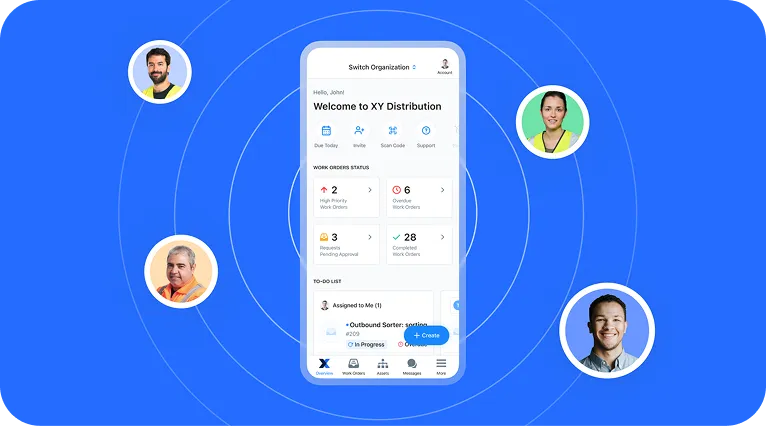
Running an efficient maintenance operation means knowing which tasks take priority over others.
By managing and prioritizing work orders effectively, you reduce downtime, improve equipment reliability, and address urgent issues quickly. A clear prioritization strategy for maintenance keeps your team focused on the tasks that impact production and operations the most.
Let's break down work order prioritization—what it is, how to start, and why it matters for your team.
Key takeaways
- Effective work order prioritization reduces unplanned downtime and improves resource allocation for your maintenance team.
- Base priority levels on a clear framework that considers urgency, operational impact, safety risks, and resource availability.
- A systematic priority matrix helps you maintain consistency and make data-driven decisions across all facilities.
- Using a computerized maintenance management system allows you to automate prioritization decisions while providing real-time visibility into the status of every work order.
What is work order prioritization?
Work order prioritization means ranking your maintenance tasks by what matters most—how urgent they are, how they'll impact operations, and what resources you have available.
Modern computerized maintenance management systems (CMMS) automate this process, helping maintenance teams move beyond manual spreadsheets and paper-based systems. Prioritization ensures critical tasks, such as emergency repairs, receive immediate attention, while lower-impact preventive maintenance tasks are scheduled appropriately.
When you build prioritization into your maintenance workflow, your teams spend time on what actually matters—keeping critical equipment running longer and avoiding costly and unexpected breakdowns.
Why prioritizing work orders matters
Smart work order prioritization helps maintenance teams tackle the right tasks at the right time. It minimizes equipment downtime and stops your team from spreading themselves too thin.
When you assign priority levels to each task, your team focuses on what matters most. You focus your technicians on critical equipment first, then fit routine maintenance into the schedule.
Maintenance teams achieve several key advantages with work order prioritization:
- Increased operational efficiency
- Reduced key asset breakdowns on critical equipment
- Better allocation of resources and staff
- Improved response times for urgent situations
- Extended equipment lifespans
Cut Downtime With MaintainX
Understanding each work order priority level
Understanding how to group work orders by priority level is essential for streamlining your maintenance operations. Not every work order carries equal urgency. Assigning the right level ensures that teams tackle the most critical tasks first.
High priority
High-priority work orders involve vital maintenance work that must be completed immediately, usually to prevent a hazardous situation or avoid serious disruptions to operations. A high-priority task might include addressing the breakdown of a critical machine, cleaning up a chemical spill, or responding to emergency requests that directly affect production.
For example, if an HVAC system fails in a manufacturing plant during the summer, the shop floor becomes dangerously hot. This creates unsafe working conditions that impact production and worker health.
Medium priority
Medium-priority tasks are important issues that you need to address within a reasonable timeframe but don't require immediate action. If delayed, these tasks may slow down an operator's work, but they don't immediately risk safety or production.
For example, scheduling maintenance to replace aging circuit breakers is a medium-priority task. While it's vital for preventing electrical issues down the road, you can schedule the replacement for the near future without needing to take immediate action.
Low priority
Low-priority work orders apply to situations that don't immediately affect operations or safety. For example, repainting equipment housing for aesthetic purposes or replacing worn floor markings in a warehouse aisle are low-priority tasks. While you should eventually address these tasks for facility appearance and organization, they pose no immediate risk to production capacity or worker safety.
How to create a work order priority matrix
A work order priority matrix is a simple but powerful tool for standardizing how you rank maintenance tasks. It helps your team move beyond guesswork by providing a clear, visual framework for making decisions.
The most common approach for CMMS users combines two key factors:
- Urgency: How quickly do you need to address the task to prevent failure, safety incidents, or compliance issues?
- Impact: What are the consequences if you delay the task? This includes production loss, equipment damage, safety hazards, or repair costs.
By plotting tasks on a matrix with these two axes, maintenance managers can quickly separate work orders into these categories:
- High urgency, high impact (high priority): Critical production line failure at a manufacturing facility
- Low urgency, high impact (medium priority): Scheduled bearing replacement during planned downtime
- Low urgency, low impact (low priority): Cosmetic repair in a non-production area
Using a matrix ensures everyone on your team applies the same logic, leading to more consistent maintenance request management.
Standardize Priorities Across Sites
How to prioritize work orders and maintenance requests
Work order prioritization in manufacturing and industrial facilities requires evaluating multiple factors systematically. The urgency of the task, its impact on operations, and available resources all influence your decisions.
Before assigning priorities, gather key information:
- Estimated completion time: Based on similar maintenance tasks
- Task complexity: Required skill level and specialized tools
- Resource availability: Technician schedules and parts inventory
- Operational impact: Effect on production capacity and safety
This systematic approach ensures your team handles the most critical tasks first while scheduling routine maintenance appropriately.
Estimate effort and difficulty
When prioritizing maintenance requests, consider the effort each task requires, as well as the complexity of the work. Historical data from similar service tickets helps estimate a task's completion time.
Also, consider the skill level of personnel in-house. Some tasks require specialized technicians with special training. Balancing these factors lets you use your resources more efficiently, and allows teams to complete their work more quickly as you're assigning the job to the right person.
Evaluate impact and urgency
Keep productivity in mind when prioritizing maintenance tasks, as well as the overall impact the job has on operations. The most urgent tasks should address issues that greatly affect critical assets, produce a safety threat, or bring production to a screeching halt.
For example, shutting down a piece of equipment for an hour to take care of a smaller problem may prevent you from spending even more time and money on emergency repairs later. By understanding the urgency and potential consequences of each service request, you can take care of the highest-impact issues promptly and keep operations running like clockwork.
Consider technician availability and allocation
Technician availability is key to prioritizing maintenance work. When generating a maintenance request, be mindful of which technicians will be on duty.
Assign specialized work to staff with the proper skills or certifications to do the job. Assigning a task to the wrong person slows everything down. By giving the right job to the right person, you ensure they'll perform efficient and effective maintenance, reducing the risk of errors and rework.
Review availability of parts and equipment
Before scheduling a maintenance task, confirm that you have all necessary parts, tools, and equipment on hand. Without the materials you need, your team won't be able to get a job done on time.
This creates a chain reaction of delays and inefficient operations. Confirming the availability of necessary items in advance keeps everyone from wasting time and resources, allowing the maintenance team to proceed as planned. Review equipment and spare parts stocks before prioritizing tasks, so you avoid unnecessary rescheduling and keep your maintenance operations on track.
Consider your other work requests
After considering other factors like urgency, availability, and material requirements, review your open maintenance requests. Determine whether it makes sense to reprioritize some tasks based on new information or shifting needs.
By considering how long each pending task takes, you address high-priority items first. This big-picture approach helps you maintain a balanced workload for your team.
Optimize Scheduling With Real-Time Visibility
How MaintainX simplifies work order prioritization
MaintainX CMMS software simplifies work order prioritization through advanced maintenance software features. For example, Duracell, a global industry leader in batteries, was able to digitize its entire inventory and work order management flow with the platform. Now, it closes over 1,000 work orders per month at every site.
Core work order prioritization features
- Reporting and analysis tools: Keep track of historical trends, key performance indicators (KPIs), and overdue maintenance requests to better prioritize tasks and forecast for predictive maintenance efforts.
- Resource allocation planning: Easily distribute tasks based on technician availability, skill level, and workload to improve efficiency.
- Parts and asset management: Ensure you have all necessary parts and equipment before scheduling maintenance requests, preventing delays.
Mobile and communication tools
- Mobile accessibility: Enable technicians to access, update, and close out service tickets in real-time with a mobile device.
- Real-time communication tools: Allow teams to collaborate across facilities with instant updates, reducing miscommunication and delays.
Automation and standardization
- Preventive maintenance scheduling: Automate preventive maintenance tasks to ensure essential equipment maintenance is completed on time.
- Customizable work order templates: Standardize task creation with customizable templates to save time on repetitive tasks.
- Performance tracking: Monitor technician productivity and task completion rates while identifying improvement opportunities.
- Multi-location dashboards: Manage maintenance requests across different facilities from one central platform with customized dashboards.
The final word on work order prioritization
Effective work order prioritization is the foundation of modern maintenance operations. By moving beyond paper-based systems and reactive approaches, maintenance teams focus on keeping critical assets running and production capacity optimized.
Ready to transform your maintenance operations from reactive to proactive? Sign Up for Free and see how MaintainX helps over 13,000 customers reduce unplanned downtime while improving operational efficiency across manufacturing, logistics, and industrial facilities.
Frequently asked questions about work order prioritization
What is a work order priority?
A work order priority is a ranking of urgency for a task. Priority determines the order in which issues should be addressed, giving you confidence that emergency situations, like equipment failures or safety hazards, are taken care of first. Less critical tasks can be scheduled for the following day or even the next week. When you prioritize maintenance tasks, you can better direct your resources and keep operations running smoothly.
Why is work order prioritization important for maintenance?
Work order prioritization lets you be sure that maintenance teams handle the most important tasks first. By prioritizing work orders, you can direct your team's attention to what will make the biggest difference, prevent bottlenecks, and avoid lengthy delays. This process also makes the best use of skilled personnel, helps you take care of safety issues quickly, and keeps your equipment operational, leading to a smoother work day for everyone and overall cost savings for the company.
Who should set work order priorities?
Maintenance managers and supervisors with a firm understanding of operations and maintenance needs are usually the ones who set work order priorities. They typically know best how to determine the urgency of a task and how it will affect production and safety. Some cases may require input from technicians, facilities managers, or other key stakeholders to make sure that priorities and operational goals line up and that the company has the necessary resources to perform the task.
What criteria should be used to prioritize maintenance work orders?
When prioritizing maintenance work orders, consider the impact of an issue on safety and operations. Keep the availability of resources such as personnel, parts, and equipment in mind. Other factors also play a vital role in determining priority levels, such as potential downtime caused by delaying a task, how much the company relies on the asset being serviced, and potential legal or financial risks that might come along with not taking action. These standards help handle critical tasks quickly and accurately, while you can schedule less urgent tasks for a time that makes sense.
What are the standard priority levels for maintenance work orders in manufacturing facilities?
Most maintenance management systems use four levels: P1 (Critical) for immediate safety or production threats, P2 (High) for issues that will impact production within 24–48 hours, P3 (Medium) for scheduled preventive maintenance and repairs, and P4 (Low) for minor improvements with no immediate operational impact.
How should maintenance managers prioritize work orders when multiple critical assets need attention simultaneously?
Evaluate secondary factors like downstream process impact, cost of failure, and safety risk level. Use your facility's asset criticality rankings and consider which equipment failure would halt the most production lines or create the highest safety hazard for your team.
What factors should maintenance teams consider when creating a priority matrix for industrial equipment in asset-intensive industries?
Focus on asset criticality (production impact), safety risk (injury potential), regulatory compliance requirements, and economic factors like downtime costs and repair expenses. Manufacturing facilities should also consider shift schedules and planned maintenance windows when setting priorities.






